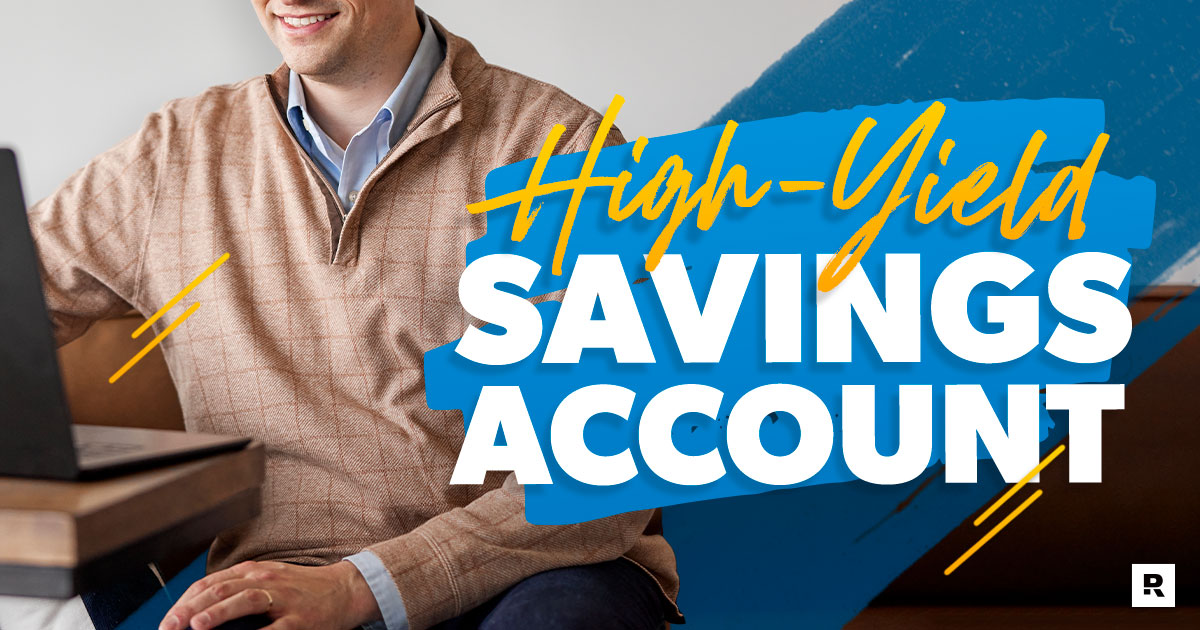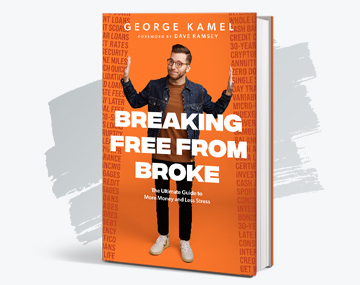What Is a High-Yield Savings Account and Do I Need One?
8 Min Read | Apr 16, 2024

All right, here’s the deal with traditional savings accounts: In most cases, they stink as bad a middle school boys’ locker room. That’s because the money you put into those accounts grows at about the same rate as I did in middle school—not much at all. Traditional savings accounts have an average interest rate of 0.46%.1 Which means, if you put $1,000 into a typical account, over the course of an entire year you would earn . . . $4.60. That’s barely enough money to take someone on a date to the Costco food court (long live the $1.50 hot dog combo).
Luckily, there’s a much better alternative these days: high-yield savings accounts (HYSA). High-yield savings accounts offer significantly higher interest rates than traditional savings accounts. I love spreading the good news about them whenever I co-host The Ramsey Show, and even in my book, Breaking Free From Broke.
I want to make you a believer too. So let’s break down the answers to a few important questions, like “What is a high-yield savings account?” and “How do I find the best high-yield savings accounts?” Here’s a preview of where we’re headed:
- What Is a High-Yield Savings Account?
- How a High-Yield Savings Account Works
- Pros and Cons of a High-Yield Savings Account
- How to Open a High-Yield Savings Account
- How to Find the Best High-Yield Savings Account
Key Takeaways
1. High-yield savings accounts offer much better interest rates than traditional savings accounts—as much as 10 times higher.
2. If you’re looking for somewhere to put your emergency fund or to save money for short-term financial goals, high-yield savings accounts are a great choice.
3. Investing in mutual funds is a better option than HYSAs for long-term financial goals.
What Is a High-Yield Savings Account?
A high-yield savings account (sometimes called a high-interest savings account) is a type of savings account offered by banks and credit unions that has a higher interest rate than traditional savings accounts.
While traditional savings accounts average a 0.46% interest rate, plenty of high-yield savings accounts offer rates over 4%. If you’re doing the math at home, that’s nearly 10 times more.
How a High-Yield Savings Account Works
Here’s how high-yield savings accounts work: By offering a higher interest rate, the accounts can help you turn up the heat on meeting your money goals. Now, we’re not talking bonfire heat here—maybe more like Easy-Bake Oven heat. But either way, because high-yield savings accounts offer higher interest rates than traditional savings accounts, the money you put in will grow faster.
Let’s look at an example: We’ll say Nathan is saving to buy a house, and he puts the $10,000 he’s already saved up into a high-yield savings account at a 4% annual percentage yield (APY). If he doesn’t touch the account for a year, he’ll have earned about $400 in interest by the end of the 12 months. If Nathan had put that $10,000 in a traditional savings account earning 0.46%, he only would’ve made $46. Oof.
How are these accounts able to offer such high interest rates? Most high-yield savings accounts are available through online banks, which don’t have to pay rent or any of the other expenses involved in operating a brick-and-mortar building, like buying lobby furniture (and making sure the tellers are always fully stocked with Dum-Dums). That means the cost of running their business isn’t as high, and they can pass those savings on to you.
Pros and Cons of a High-Yield Savings Account
At this point, you may be wondering about the pros and cons of high-yield savings accounts. Well, the pros definitely outweigh the cons. But there are a few things that HYSAs aren’t good at. Let’s take a look.
Pros
- They have a much higher interest rate than traditional savings accounts. Like I mentioned, high-yield savings accounts sometimes offer 10 times the interest of traditional savings accounts.
- The money you put in is super safe. High-yield savings accounts at legitimate banks—even online banks—are backed by the Federal Deposit Insurance Corporation (FDIC), which insures your deposits up to $250,000 with the backing of the federal government. Legitimate online credit unions are backed by the National Credit Union Administration (NCUA). All those letters simply mean your money’s not going anywhere.
- You can access the money at any time. Unlike some investments where it can be difficult to pull your money out at a moment’s notice, high-yield savings accounts allow you to access the money at any time. That makes them a great place for keeping an emergency fund or a down payment fund if you’re saving for a house.
Cons
- They’re not a good long-term investment. Though high-yield savings accounts provide a much higher rate of return than traditional savings accounts, they’re still lousy for long-term investing. Even if a bank offers a rate of 4% or more, it doesn’t come close to the 10–12% rate of return that good mutual funds with long track records of success have historically averaged. That’s where you need to do your long-term investing for retirement or anything else more than five years down the road.
- The interest rate can change at any time. Did you find a great high-yield savings account with an online bank offering a 4.5% interest rate? Well, it may not last long. Banks can change their interest rates for savings accounts whenever they want, which means your rate isn’t a long-term (or even short-term) guarantee.
- They’re usually online only. If you’re the kind of person who hates going to the bank in person, then this one doesn’t affect you. But if you prefer talking to your bankers face-to-face and making deposits in person, then getting a high-yield savings account through an online bank may not be your cup of tea. But remember, you can still use a local bank for your everyday checking account.
How to Open a High-Yield Savings Account
Opening a high-yield savings account is a lot like opening a checking account or traditional savings account—it’s super easy. Here are the three steps:
- Find a bank or credit union. You can find some great options by searching online for FDIC-insured high-yield savings accounts.
- Provide identification. You’ll have to send a picture of your passport or driver’s license and give the bank your Social Security number.
- Make a deposit. You can’t have a bank account without money! The final step to opening a high-yield savings accounts is making a deposit, which you can do by writing a check or transferring funds from another account.
How to Find the Best High-Yield Savings Account
Now you know how to open a high-yield savings account, but there’s something else we need to go over: how to find one. Here are the important things to look for when you’re trying to find the best high-yield savings account:
- A competitive interest rate: This is the big one. If most of the high-yield savings accounts out there are offering an interest rate around 4.25%, for example, you don’t want to pick one that only offers 3%. If you want to get super nerdy, you also may want to look into how a bank applies compound interest (aka their compounding method).
- No significant deposit or balance requirements: You don’t want to run into a bunch of fees for falling below a super high balance requirement. Speaking of fees . . .
- No maintenance fees: Getting nickeled-and-dimed by ongoing maintenance fees is a great way to slowly but surely lose money that’s in your account—it’s death by a thousand cuts. You want to pick an HYSA that lets you earn money.
- FDIC or NCUA insurance: Like I said, the FDIC insures your deposits up to $250,000 with the backing of the federal government. Don’t put your money into a bank that doesn’t have FDIC protection (or a credit union without NCUA protection).
- Easy access to your money: Accessing the money you put into a savings account shouldn’t be a pain in the neck. Make sure you can easily transfer funds out of the account without a withdrawal penalty. If there’s a limit on the number of withdrawals you can make, that’s okay—you shouldn’t be taking money out of long-term savings that often anyway.
Here's A Tip
To get a good look at all the options out there, just do an online search for “FDIC-insured high-yield savings accounts.” Don’t forget to make sure the bank you choose checks all of these boxes before you pull the trigger. And avoid HYSAs that are offered by credit card companies—they might offer some interest, but they don’t have your best interest at heart. (See what I did there?)
The Bottom Line
Here’s the important thing to remember: When deciding whether a high-yield savings account is right for you, it all comes down to what your goal is.
Calculate the growth of your savings account with this free tool.
If you’re looking for a place to keep some cash you’ve stockpiled while getting the perk of some extra savings, a high-yield savings account definitely fits the bill. It’s a terrific destination for sinking funds or your emergency fund. (If you want to keep some of your emergency fund at a brick-and-mortar bank for quicker access, that’s fine.)
But if you’re looking for a place to invest money so it can grow for the future, a high-yield savings account is a bad choice. Again, investing in good mutual funds is a much better option, as long as you won’t need the money for five years or more.
If you’re interested in long-term investing like that and you want to start making a financial plan for your future, connecting with an investing pro is a great place to start. You’ve got this!
Want more money tips?
A high-yield savings account may not be the only money hack you’re missing out on. I go over plenty of other money tips—as well as some of the biggest traps to avoid—in my book, Breaking Free from Broke. You can read the first chapter for free.
Frequently Asked Questions
-
Are high-yield savings accounts safe?
-
Yes! As long as you choose a high-yield savings account with FDIC protection, your money is totally safe—and guaranteed by the federal government up to $250,000 (per depositor, per institution and per ownership category—if you want to get super nerdy).
-
How much does $1,000 earn in a high-yield savings account?
-
The amount you’ll earn with a $1,000 deposit depends on the interest rate of your individual bank. For example, if your bank has a 4% annual interest rate, you’ll earn $40 in a year. Or if your bank has a 4.5% rate, you’ll earn $45.
-
How often do savings rates change?
-
It depends on which bank you use—each bank gets to make its own decisions about when to change savings rates.
-
Are high-yield savings accounts a good investment?
-
High-yield savings accounts are not a good long-term investment, but they’re a great place to keep your emergency fund or money you’re setting aside for a short-term savings goal.



